|
HOME: www.hiltonpond.org |
|||
THIS WEEK at HILTON POND Subscribe for free to our award-winning nature newsletter (Back to Preceding Week; on to Next Week) |
AUTHOR'S PREFACE: September 15, 2013 marked my 67th birthday. Facebook used to host "Birthday Causes" through which friends could donate to the celebrant's favorite charity. It was an effective way to raise funds for Hilton Pond Center & Operation RubyThroat, but even though FB canceled the program we need operating funds. Thus, I'm still designating Hilton Pond Center as my "Birthday Cause" for 2013. If you find "This Week at Hilton Pond" to be informative or fun to read, or if you've learned something about hummers through Operation RubyThroat, please consider granting my "Birthday Cause" wish by making a tax-deductible donation via PayPal or Network for Good (links are below), or by check (1432 DeVinney Road, York SC 29745). The goal was to have $3,500 by 30 September and generous contributors have donated $2,187 to date. (We'll count anything received within 30 days of 15 September toward the "Birthday Cause" drive.) Thanks for your support, and thanks for letting me share my love of nature with you! BILL HILTON JR. All contributions are tax-deductible on your NORTHERN FLICKER: This week we were in Fayette County, West Virginia for a big chunk of time at the annual "Hawk Gawk & Warbler Walk" offered through New River Birding & Nature Center. On two of the days we WERE at Hilton Pond Center it rained or was too windy, leaving the first and the tenth of October as the only times we could deploy mist nets. All this means we probably missed some Neotropical migrants moving past the Center; to date we've had one of our slowest autumns ever as far as banding is concerned. We did manage to trap what are likely our last two Ruby-throated Hummingbirds of 2013 while netting two migrant thrush and seven warbler species, but perhaps the most interesting bird of the week showed up at sunset on 10 October. Just as we were preparing to shut down for the night we looked out the window above our computer desk in the old farmhouse and saw a large-ish dark bird flapping about in the bag of a nearby net. At first we thought it was a raptor--maybe one of the Sharp-shinned Hawks or Cooper's Hawks that torment (and sometimes eat) our feeder birds--but a flash of brilliant white against the dark green background vegetation gave us our cue: The rump patch of a Northern Flicker!
All text, maps, charts & photos © Hilton Pond Center We bounded outside faster than usual, not wanting this big bird to escape from the small-mesh net that held it. We arrived to learn the flicker was a kicker, so we gently grabbed its fast-moving legs legs, removed it from the net, and slid it into a lingerie bag we use for transport--a necessity in this case because we now needed both hands to set up our camera and tripod. We knew from experience the 60mm macro we usually keep on our Canon SLR camera would be too long a lens; alas, our arms just aren't long enough when we hold a big bird for profile photos. Even the 50mm macro was probably going to be too long, but we mounted it anyway because a wide-angle lens wouldn't be good for close-ups. When the gear was finally ready, we removed the bird from the lingerie bag and began documenting our twilight capture. (Disclaimer: For some reason we often catch unusual birds right at dusk with darkness coming on fast. Thus, images herein were made via flash, even though we much prefer to use available light. Our newly caught flicker was also hyperactive, so some photos aren't quite as sharp as we might like. Our apologies.)
All text, maps, charts & photos © Hilton Pond Center So why such interest in this Northern Flicker, you might ask--a bird that was once called "Common Flicker" because, well, because it's pretty common across most of its range. The reason we wanted photos is because it was the first flicker we'd caught at Hilton Pond Center in 14 years and only the 36th since 1982 . . . making it one of our rarer species and one for which we had few photos. Curiously, as illustrated on the chart above, two-thirds (24) of our 36 flickers were captured during a brief five-year period (1990-94)--a phenomenon we'll try to explain forthwith.
All text, maps, charts & photos © Hilton Pond Center The Northern Flicker is one of those birds whose name does NOT indicate its taxonomy. As one might guess from its shape and long bill, the flicker is in the Woodpecker Family (Picidae), but it's different from other woodpeckers not only in name but in behavior and habitat. Our most common local picid, the Downy Woodpecker (195 banded to date), is much more prevalent now than it was 32 years ago--likely for the same reason Northern Flickers are less common. As we've pointed out many times, our 11 acres have changed considerably in the past three decades, going from open grassy lawn to young mixed woodland. Downy Woodpeckers inhabit the latter, while flickers like the former.
All text, maps, charts & photos © Hilton Pond Center As their name suggests, most woodpeckers use long bills to peck holes in trees from which they extract insect grubs. The ever-more-mature hardwoods at Hilton Pond are just what Downy Woodpeckers need to provide food and eventual nesting sites, but Northern Flickers go at feeding a bit differently; they forage primarily on the ground, where they insert long sticky tongues into ant tunnels and lap up these social insects. In fact, ants typically make up nearly half a flicker's diet, the remainder of its invertebrate fare coming from beetles, butterflies, and moths (some caught on the wing). But back to the decline in Northern Flickers at Hilton Pond Center, as noted on our chart above; we think it's habitat-based. The property was mostly open when we first arrived in 1982, so there were lots of grassy areas where flickers could seek out anthills and feed on their insects of choice; in those days we'd capture one to three flickers per year. Things changed in the early 1990s when grass soon gave way to shrubs and the only lawn left was around the old farmhouse--right where the majority of out bird-catching mist nets were located--so we caught our biggest numbers of flickers. Eventually, as canopy trees shaded out these last vestiges of lawn and we gave up mowing everything except our trails, Northern Flickers ran out of places to feed, and they just don't come around any more.
All text, maps, charts & photos © Hilton Pond Center We've often said the Northern Flicker looks like a bird put together by a committee, with each member amending the bird's appearance with his or her favorite attribute (see photos above). There's that startling white rump patch, of course, which contrasts with heavy barring on the flicker's back.
All text, maps, charts & photos © Hilton Pond Center Despite all these plumage attributes, the most striking parts of the Northern Flicker we caught this week at the Center were the feathers of its wing (above) and tail (below)--each of which had a bright yellow shaft that gave the bird another of its former names: Yelllow-Shafted Flicker. This is the state bird of Alabama, where it's sometimes called the Yellowhammer (or, more colloquially, "yaller-hammer.") By the way, the flicker gets its name from flicking its bill--not its tail--and to our ears, the call of the Northern Flicker sounds like "flick-flick-flick-flick-flick." (NOTE: In the image below you also can see very stiff and pointed tips on the central tail feathers--a useful adaptation that helps stabilize the flicker when it perches vertically on a tree trunk.)
All text, maps, charts & photos © Hilton Pond Center And that brings us to a discussion of why old field guides call this bird "Yellow-shafted Flicker," somewhat newer ones say "Common Flicker," and today the accepted terminology is "Northern Flicker." If you've ever been to the western U.S. you may have seen flickers that look a bit unlike the one we caught this week at Hilton Pond. Major field marks are the same, but underwings and undertail and feather shafts out west are red rather than yellow, hence the name "Red-shafted Flicker." These birds are so different in appearance--especially from beneath--they were considered to be two separate species. Bird behaviorists have been hard at work, however, and discovered these birds interbreed where their populations overlap, meaning they must be the same species; thus, the two have been relegated to subspecies ranking with the (yellow-shafted) Northern Flicker listed as Colaptes auratus auratus and the (red-shafted) Northern Flicker as C. a. cafer. It's interesting that a third bird--the Gilded Flicker, C. chrysoides--has a range in Arizona that overlaps that of the red-shafted variety with which it seldom interbreeds; therefore, Gilded Flicker retains full species status, at least for now.
All text, maps, charts & photos © Hilton Pond Center Bird geneticists do currently support the above-mentioned delineation of flicker subspecies and species, but sometimes we wonder if these birds are even woodpeckers at all. (John James Audubon--see his rendering above--recognized what he called "Golden-winged Woodpeckers" were quite unlike other picids he saw in eastern woods.) As we know from banding and observing them at Hilton Pond Center, flickers have slightly decurved bills, they peck anthills instead of wood, they feed mostly on the ground rather than in trees, they exhibit a hodge-podge of field marks, and about the only plumage character they have in common with the rest of the Picidae is red on the backs of their heads. So maybe all the flickers deserve their own family; in light of their atypical behaviors and unusual appearance, we suggest Colluvidae--from the Latin word for "all jumbled up." All text, maps, charts & photos © Hilton Pond Center All contributions are tax-deductible on your |
|---|
|
"This Week at Hilton Pond" is written and photographed by Bill Hilton Jr., executive director of Hilton Pond Center for Piedmont Natural History
|
|
|
Please refer "This Week at Hilton Pond" to others by clicking on this button: |
Comments or questions about this week's installment? Send an E-mail to INFO. (Be sure to scroll down for a tally of birds banded/recaptured during the period, plus other nature notes.) |

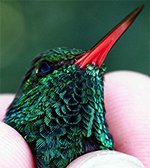




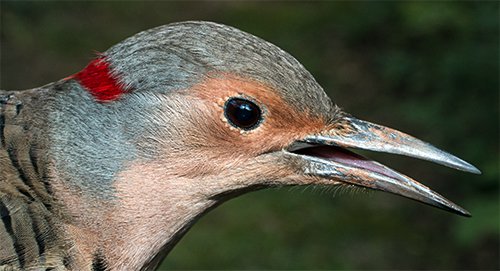
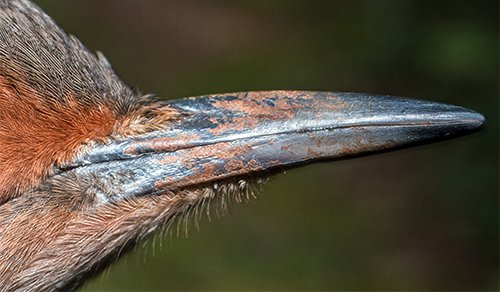
 Flickers also eat lots of berries--expecially in cooler weather--as evidenced by dark purple stains in the white lingerie bag that temporarily held the one we caught. The fruit of Flowering Dogwood
Flickers also eat lots of berries--expecially in cooler weather--as evidenced by dark purple stains in the white lingerie bag that temporarily held the one we caught. The fruit of Flowering Dogwood 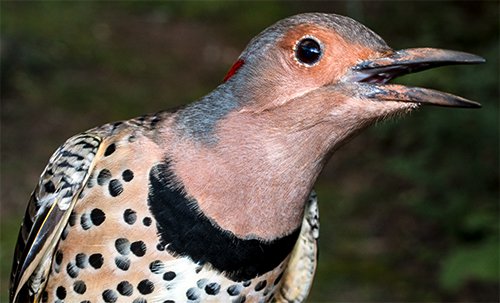
 A rich pinkish-brown throat leads to a black bib, and it's hard to miss all those big black spots on the flicker's belly and breast. Top everything off with a gray crown contrasting sharply with a brilliant crimson nape and the Northern Flicker is indeed a hodgepodge of field marks.
A rich pinkish-brown throat leads to a black bib, and it's hard to miss all those big black spots on the flicker's belly and breast. Top everything off with a gray crown contrasting sharply with a brilliant crimson nape and the Northern Flicker is indeed a hodgepodge of field marks. 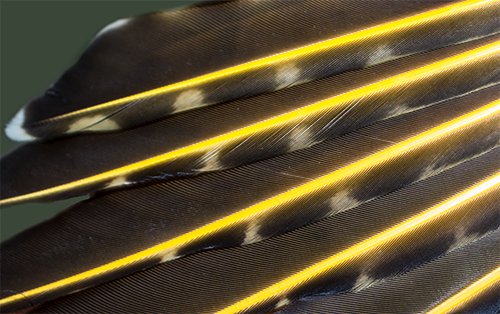
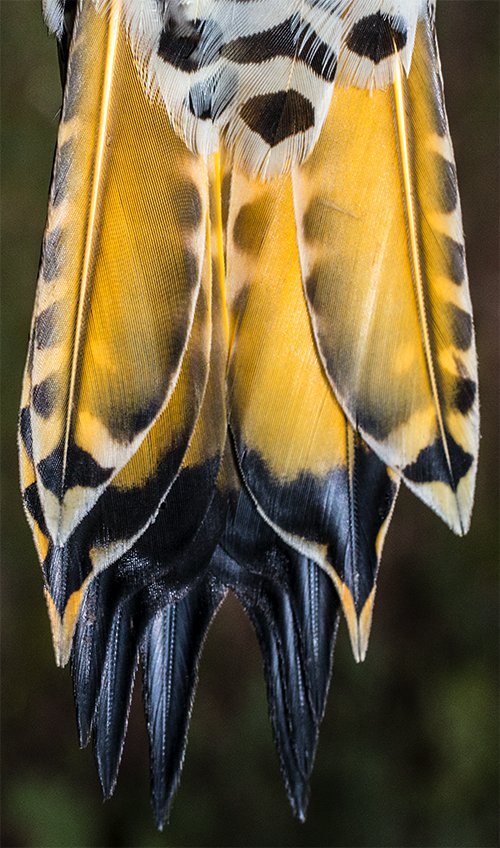
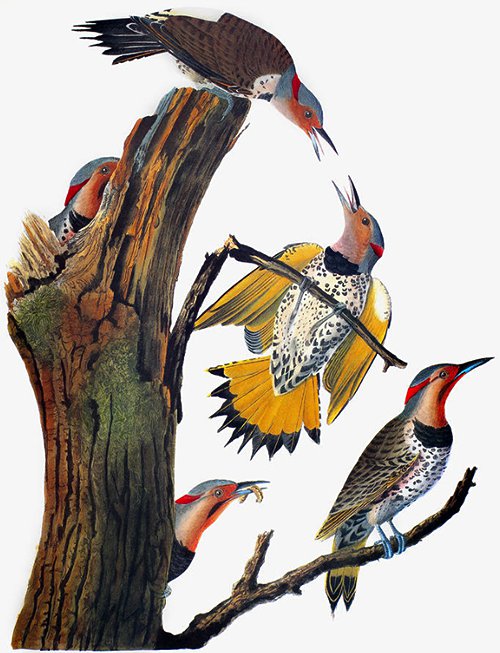






 Please report your sightings of
Please report your sightings of